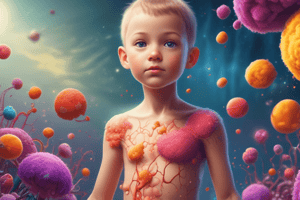Podcast
Questions and Answers
What is the peak incidence age range for acute lymphoblastic leukemia (ALL)?
What is the peak incidence age range for acute lymphoblastic leukemia (ALL)?
- 45 to 50 years
- 2 to 6 years (correct)
- 10 to 16 years
- 20 to 30 years
Which genetic disorder is associated with a higher risk of developing ALL?
Which genetic disorder is associated with a higher risk of developing ALL?
- Klinefelter syndrome
- Down syndrome (correct)
- Turner syndrome
- Marfan syndrome
What is the primary clinical manifestation of ALL?
What is the primary clinical manifestation of ALL?
- Excessive thirst
- Increased energy levels
- Anemia (correct)
- Weight gain
Which diagnostic test is crucial in confirming ALL?
Which diagnostic test is crucial in confirming ALL?
What is the main purpose of systemic chemotherapy in ALL management?
What is the main purpose of systemic chemotherapy in ALL management?
Which surgical procedure is a treatment option for acute leukemias?
Which surgical procedure is a treatment option for acute leukemias?
What is the female louse's life span when away from the human host?
What is the female louse's life span when away from the human host?
Where does the female louse lay her eggs?
Where does the female louse lay her eggs?
What does leukemia refer to?
What does leukemia refer to?
Which type of leukemia is characterized by an abnormal increase of immature white blood cells called 'blasts'?
Which type of leukemia is characterized by an abnormal increase of immature white blood cells called 'blasts'?
From where does hematopoiesis occur?
From where does hematopoiesis occur?
What do platelets help with in the blood?
What do platelets help with in the blood?
Flashcards are hidden until you start studying
Study Notes
Classification of Leukemias
- Leukemias can be classified into two main categories: acute and chronic
- Acute leukemias can be further classified into two subcategories: lymphocytic and myelogenous
- Lymphocytic leukemia is also known as lymphoblastic leukemia, and myelogenous leukemia is also known as myeloid or nonlymphocytic leukemia
- Chronic leukemias can also be classified into two subcategories: lymphocytic and myelogenous
- Chronic lymphocytic leukemia (CLL) and chronic myelogenous leukemia (CML) are two types of chronic leukemias
Acute Lymphoblastic Leukemia (ALL)
- Peak incidence of ALL occurs in children between 2-6 years old
- Median age of adults with ALL is 35 years
- Boys are more affected than girls
- Causes of ALL include:
- Congenital disorders (e.g. Down syndrome)
- Familial tendency (genetics)
- Viruses
- Clinical manifestations of ALL include:
- Generalized weakness and fatigue
- Anemia
- Frequent or unexplained fever and infection
- Weight loss and/or loss of appetite
- Excessive and unexplained bruising
- Bone pain and joint pain
- Breathlessness
- Enlarged lymph nodes, liver, and/or spleen
- Petechiae (tiny red spots or lines in the skin due to low platelet levels)
Diagnostic Tests for ALL
- Bone marrow aspiration
- Bone marrow biopsy
- Blood counts (showing severe anemia, thrombocytopenia, and neutropenia)
- Differential leukocyte count (determines cell type)
- Lumbar puncture (detects meningeal involvement)
Treatment of ALL
- Pharmacologic treatment:
- Vincristine (anti-cancer chemotherapy drug)
- Prednisone (alters the body's normal immune system responses)
- Antibiotics, antifungals, and antivirals (control infection)
- Medical management:
- Systemic chemotherapy (aims to eradicate leukemic cells and induce remission)
- Radiation therapy (given for testicular infiltrations)
- Platelet transfusion (prevents bleeding)
- RBC transfusion (prevents anemia)
- Surgical treatment:
- Stem cell transplant
- Bone marrow / Stem Cells transplant
Complications of ALL
- Infection
- Bleeding
- Anemia
- Organ infiltration
Pediculosis Capitis (Head Lice)
- Common parasite in school-age children
- Adult louse lives for 48 hours when away from human host, and female louse lays eggs at night at the junction of a hair shaft and close to the skin
- Eggs hatch in 7-10 days
Leukemia
- A type of cancer of the blood or bone marrow
- Characterized by an abnormal increase of immature white blood cells called "blasts"
- Leukemia is a broad term covering a spectrum of diseases
- Classified according to what type of WBC affected
- Two most common types: Acute lymphoid leukemia (ALL) and Acute non-lymphoid (myelogenous) leukemia (AMLL or AML)
Bone Marrow and Blood Cell Formation
- Bone marrow is the soft, spongy tissue in the center cavity of all bones
- Hematopoiesis (blood cell formation) occurs in red bone marrow
- All blood cells are derived from a common stem cell (hemocytoblast)
- Blood cells produced in the bone marrow include:
- Red blood cells (carry oxygen and other materials)
- White blood cells (fight infection)
- Platelets (help the blood clot)
Studying That Suits You
Use AI to generate personalized quizzes and flashcards to suit your learning preferences.




